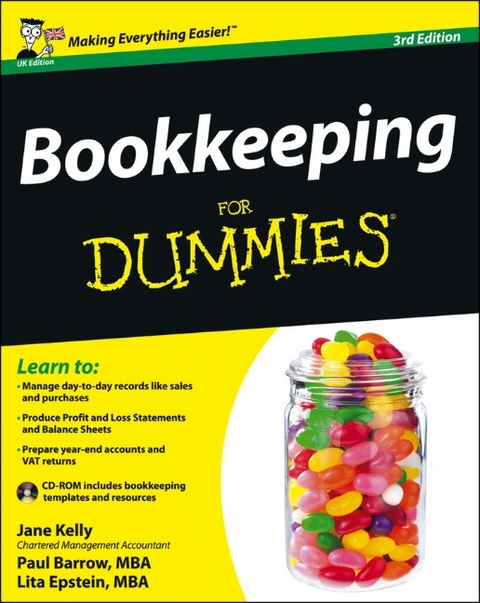
Bookkeeping For Dummies
John Wiley & Sons Inc (Verlag)
978-1-118-34689-1 (ISBN)
- Titel erscheint in neuer Auflage
- Artikel merken
* Get started find out why bookkeeping is essential to your company success, how it's done and where to start * Keep a paper trail enter and post financial transactions, keep a detailed record, and set up internal controls for managing your books and your cash * Take it one day at a time discover how to keep track of day-to-day operations, as well as adjustments to sales and purchases * Keep the payroll rolling get the lowdown on setting up and managing payrolls, as well as all the HM Revenue & Customs paperwork involved in hiring a new employee * Close out the books learn how to close out monthly, quarterly or yearly accounting periods and calculate and record depreciation, interest payments and receipts * Make it official find out how to prepare financial reports and profit and loss statements, properly fill out all required tax forms and prepare your books for next year Open the book and find: * How to create and maintain your company's financial records * The best ways to keep books up-to-date with technology * How to set up and maintain employee records * How to calculate your staff's net pay * Guidance on producing income statements and financial reports * A wealth of practical exercises and examples throughout the book Learn to: * Manage day-to-day records like sales and purchases * Produce Profit and Loss Statements and Balance Sheets * Prepare year-end accounts and VAT returns CD-ROM includes bookkeeping templates and resources Note: CD files are available to download when buying the eBook version
Jane Kelly is a Chartered Management Accountant and author of Sage 50 Accounts For Dummies. She teaches bookkeeping courses for small businesses and works with mature students providing accountancy training at all levels. Paul Barrow is a Chartered Accountant with over 20 years' consulting, training, writing and commercial experience. Lita Epstein designs and teaches online courses in investing, finance and tax.
Introduction 1 Part I: Basic Bookkeeping: Why You Need It 7 Chapter 1: So You Want to Do the Books 9 Chapter 2: Getting Down to Bookkeeping Basics 21 Chapter 3: Outlining Your Financial Roadmap with a Chart of Accounts 39 Chapter 4: Looking at Ledgers 59 Chapter 5: Discovering Different Business Types 85 Part II: Recording Day-to-Day Business Operations 95 Chapter 6: Planning and Controlling Your Workload 97 Chapter 7: Counting Your Sales 109 Chapter 8: Buying and Tracking Your Purchases 135 Chapter 9: Doing Your Banking 151 Part III: Preparing the Books for Year- (Or Month-) End 167 Chapter 10: Adjusting Your Books 169 Chapter 11: Depreciating Your Assets 187 Chapter 12: Adding the Cost of Value Added Tax (VAT) 199 Part IV: Reporting Results and Starting Over 213 Chapter 13: Producing a Profit and Loss Statement215 Chapter 14: Developing a Balance Sheet 231 Chapter 15: Reporting for Not-For-Profit Organisations 249 Chapter 16: Preparing Your Year End Accounts 267 Part V: Payroll Preparation 273 Chapter 17: Employee Payroll and Benefits 275 Chapter 18: Completing Year-End Payroll and Reports 299 Part VI: The Part of Tens 311 Chapter 19: Top Ten Ways to Manage Your Business Cash with Your Books 313 Chapter 20: Top Ten Most Important Accounts for Any Bookkeeper 317 Appendix A: Glossary 321 Appendix B: About the CD 327 Index 331
| Zusatzinfo | Illustrations |
|---|---|
| Verlagsort | New York |
| Sprache | englisch |
| Maße | 186 x 235 mm |
| Gewicht | 694 g |
| Themenwelt | Sachbuch/Ratgeber ► Beruf / Finanzen / Recht / Wirtschaft ► Wirtschaft |
| Wirtschaft ► Betriebswirtschaft / Management ► Rechnungswesen / Bilanzen | |
| ISBN-10 | 1-118-34689-0 / 1118346890 |
| ISBN-13 | 978-1-118-34689-1 / 9781118346891 |
| Zustand | Neuware |
| Haben Sie eine Frage zum Produkt? |
aus dem Bereich



